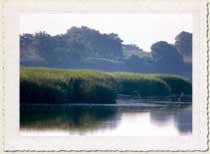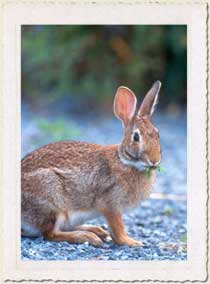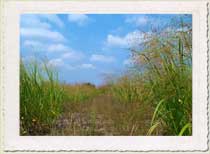
Marine Park Preserve
Borough: Brooklyn
Acres: 530
Habitat Type: Grassland, Salt Marsh
Most of the Marine Park Preserve consists of salt marshes and uplands that flank Gerritsen Creek, the westernmost freshwater inlet of Jamaica Bay. Jamaica Bay is an 18,000-acre wetland estuary that provides a unique environment for both wildlife preservation and urban recreation. Enclosed by the Rockaway Peninsula and protected from the Atlantic Ocean, the region currently hosts over 325 species of birds, 50 species of butterflies, and 100 species of finfish. A favorite stop for migratory waterfowl, the area is an integral part of the larger, regional ecosystem.
Broad expanses of salt marsh, meadows adorned with wildflowers, sand dunes held in place by beach plants, and thickets of shrubs and vines dominate the landscape of Marine Park. Myrtle warblers (Dendroica coronata), grasshopper sparrows (Ammodramus savannarum), cotton-tailed rabbits (Sylvilagus floridanus), ring-necked pheasants (Phasianus colchicus), horseshoe crabs (Limulus polyphemus), and oyster toadfish (Opsanus tau) are a small sampling of the animals that inhabit these plant communities and live in or around Gerritsen Creek.
Marine Park’s sheltered creek attracts a wide variety of marsh birds. From June through August, clapper rails (Rallus longirostrus) can be heard calling throughout the marsh. In winter, freshwater and marine waterfowl find shelter in the creek. Winter visitors include greater (Aythya marila) and lesser (Aythya affinis) scaup, ruddy duck (Oxyura jamaicensis), mute swan (Cignus olor), Canada goose (Branta canadensis), and common loon (Gavia immer).
Marine Park provides some prime habitat for one of nature’s most skillful hunters: the osprey. The osprey (Pandion haliaetus) will plummet from up to 150 feet in the air and execute dramatic feet-first diving attacks on live fish. They are distinguishable by their brown backs, wings, and tails, white undersides, and distinctive brown stripe running across their heads. These large birds also build large nests and are known to nest in both natural areas, such as trees, and man-made areas, such as on light-posts and flat nesting platforms.
Photographs
Directions
Public Transit Take the N, F, B or Q train to the Avenue U stop and transfer to the eastbound B3 bus to Burnett Street and Avenue U.
By Bus: Take the B2, B9, B41, B46, or B47 to Kings Plaza and transfer for westbound B3 bus to Burnett Street and Avenue U.
By Car: Take the Belt Parkway to Kings Plaza exit (11N), then north on Flatbush Avenue. Turn left on Avenue U and continue west for 10 blocks. Pass E. 33rd Street and look for a parking lot on the right. Marine Park is located on the left side of the street.



